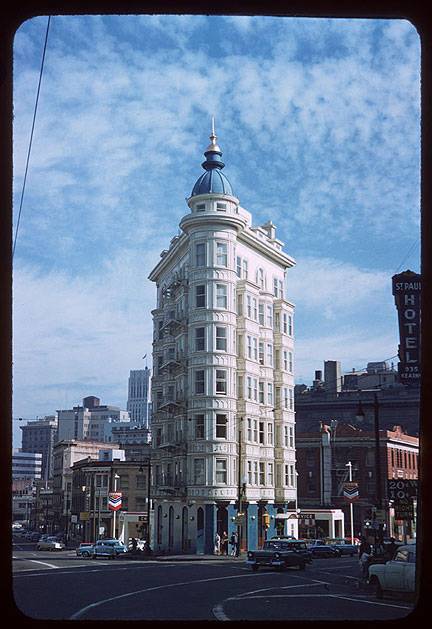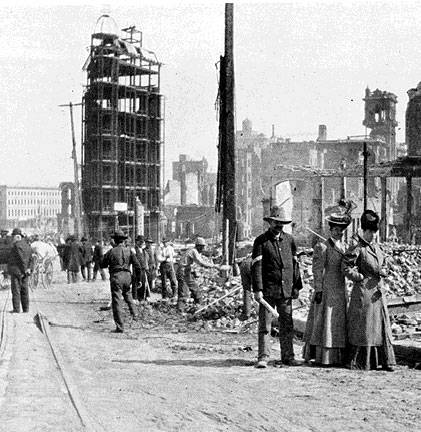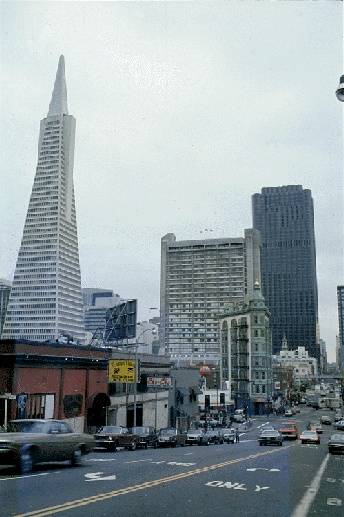The Sentinel Building: Difference between revisions
No edit summary |
m (rearranged photo order) |
||
| Line 6: | Line 6: | ||
[http://webapp1.dlib.indiana.edu/cushman/ ''Charles Cushman Collection: Indiana University Archives (P10965)''] | [http://webapp1.dlib.indiana.edu/cushman/ ''Charles Cushman Collection: Indiana University Archives (P10965)''] | ||
[[Image:Sentinel-1906.jpg]] | |||
''Sentinel Building under construction, in aftermath of 1906 earthquake and fire.'' | |||
''Photo: J.B. Monaco'' | |||
| Line 14: | Line 21: | ||
''Photo: Eddie Foronda'' | ''Photo: Eddie Foronda'' | ||
916 Kearny Street at Columbus. The Sentinel stands guard over a strategic location: the junction of downtown, Chinatown, Jackson Square, and North Beach. The spot was even more strategic before the 1906 earthquake, when the old City Hall was nearby. Perhaps that's why [[Abe Ruef and the Union Labor Party| Abraham "Boss" Ruef]], the Graft King of turn-of-the-century San Francisco, chose to build one of the City's first skyscrapers here. The building was still under construction during the 1906 earthquake but somehow escaped damage. Ruef, however, suffered a different kind of damage the next year: He was jailed during the graft prosecutions of 1907. The building wasn't finished until The Boss was released from San Quentin in 1915. | 916 Kearny Street at Columbus. The Sentinel stands guard over a strategic location: the junction of downtown, Chinatown, Jackson Square, and North Beach. The spot was even more strategic before the 1906 earthquake, when the old City Hall was nearby. Perhaps that's why [[Abe Ruef and the Union Labor Party| Abraham "Boss" Ruef]], the Graft King of turn-of-the-century San Francisco, chose to build one of the City's first skyscrapers here. The building was still under construction during the 1906 earthquake but somehow escaped damage. Ruef, however, suffered a different kind of damage the next year: He was jailed during the graft prosecutions of 1907. The building wasn't finished until The Boss was released from San Quentin in 1915. | ||
Latest revision as of 23:12, 23 July 2009
Unfinished History
The Sentinel Building at Kearny and Columbus, April 3, 1960. Note the red brick building to its right, which is the International Hotel.
Charles Cushman Collection: Indiana University Archives (P10965)
Sentinel Building under construction, in aftermath of 1906 earthquake and fire.
Photo: J.B. Monaco
View of The Trans-America Building (left) and the Sentinel Building, to the right of center.
Photo: Eddie Foronda
916 Kearny Street at Columbus. The Sentinel stands guard over a strategic location: the junction of downtown, Chinatown, Jackson Square, and North Beach. The spot was even more strategic before the 1906 earthquake, when the old City Hall was nearby. Perhaps that's why Abraham "Boss" Ruef, the Graft King of turn-of-the-century San Francisco, chose to build one of the City's first skyscrapers here. The building was still under construction during the 1906 earthquake but somehow escaped damage. Ruef, however, suffered a different kind of damage the next year: He was jailed during the graft prosecutions of 1907. The building wasn't finished until The Boss was released from San Quentin in 1915.
Francis Ford Coppola, Academy-Award-winning director of the Godfather trilogy, now owns the building, which houses the offices of his film company.
--Dr. Weirde



